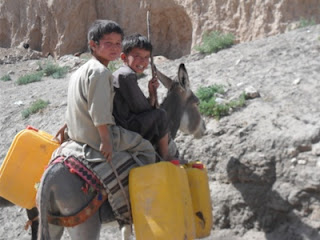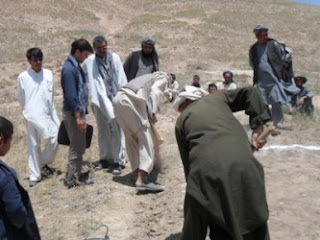Qaraghage is the second of the four regions in Charkent District and the farthest region, 167 Kilometre from Mazar city, with nine big villages each divided into three to four sub-villages, and two basic health centres.
There is a doctor and a midwife in each of the two health centres but few women come to the health centre for maternity care and childbirth. When I discussed it with Sharifa, a midwife in Qurban Quduq health centre (where we have just started to work with), she said that there have been just two deliveries since January 2011.
She also said that the villagers were not interested in going to health centre; they were more interested to go to Mullahs and remedy workers.
She also said that the villagers were not interested in going to health centre; they were more interested to go to Mullahs and remedy workers.
The villagers believes that it is the monsters who kill the women during childbirth and the women need to be kept at home to be protected against monsters during childbirth.
The Story of Shokrai
I witnessed the case of Shokria from Dashti village when we were in Qaraghage for training community health workers. It was very strange for me.
Shokria, 18 years old, Iosuf Ali's wife, in her first pregnancy . She was living just 15 minutes walk from health centre but they were not willing to go to health centre for childbirth.
She gave birth at home and was bleeding after delivery. They tried home remedies like inviting Mullahs to recite from Quran, pushing the dog to bark and burning straw to make smoke the monster go away.
She gave birth at home and was bleeding after delivery. They tried home remedies like inviting Mullahs to recite from Quran, pushing the dog to bark and burning straw to make smoke the monster go away.
But these remedies did not work and she fainted and they asked the midwife to go to their home then we sent the vehicle to bring the patient to the health centre but they rejected it.
We talked with the headman and Mullah to tell the husband to let her be transferred to the health centre. It was strange when we saw Shokria was arriving in health centre with the husband pulling her ears to protect her from monster.
Shokria was transferred back to her home after nine hours of recovering in health centre and she had no bleeding and the husband and all her family, the grandfather and Mother was very happy and thankful for the transportation and treatments.
The husband said “I was about to lose my wife just because of having wrong beliefs. I understood now that it is the bleeding which kills the women during childbirth, not the monsters and also our home remedies makes the situation worse we should take the women with bleeding to health centre instead of keeping at home”
The husband said “I was about to lose my wife just because of having wrong beliefs. I understood now that it is the bleeding which kills the women during childbirth, not the monsters and also our home remedies makes the situation worse we should take the women with bleeding to health centre instead of keeping at home”
From the left Iosuf Ali the husband pulling his wife's ears to protect her against monsters and Shokria the woman with bleeding after childbirth and the grandmother, on the way coming to health centre.



































